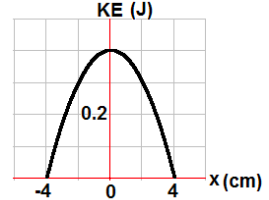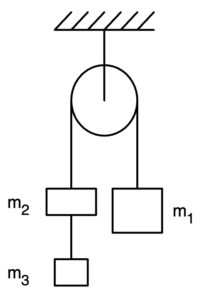0 attempts
0% avg
UBQ Credits
| Step | Derivation/Formula | Reasoning |
|---|---|---|
| 1 | [katex]KE_{\text{initial}} = \frac{1}{2} m v^2[/katex] | Calculate the initial kinetic energy of the vehicle using its speed before it halts. Here [katex]v = 12.3 \text{ m/s}[/katex]. |
| 2 | [katex]W_{\text{friction}} = f_k \cdot d = \mu_k \cdot m \cdot g \cdot \cos(\theta) \cdot d[/katex] | The work done by friction, where [katex] \mu_k = 0.650[/katex] is the coefficient of kinetic friction, [katex] g = 9.8 \text{ m/s}^2[/katex] is acceleration due to gravity, [katex] \theta = 18^\circ[/katex], and [katex]d[/katex] is the distance the vehicle slides. |
| 3 | [katex]W_{\text{gravity}} = m \cdot g \cdot \sin(\theta) \cdot d[/katex] | The work done by gravity while the vehicle moves down the incline. |
| 4 | [katex]KE_{\text{initial}} = W_{\text{friction}} + W_{\text{gravity}}[/katex] | By the work-energy principle, the initial kinetic energy is converted into work done against friction plus the work done by gravity. |
| 5 | [katex]\frac{1}{2} m v^2 = \mu_k mg\cos(\theta)d + mg\sin(\theta)d[/katex] | Substitute expressions from steps 1, 2, and 3 into the work-energy equation. |
| 6 | [katex]d = \frac{\frac{1}{2} v^2}{\mu_k g \cos(\theta) + g \sin(\theta)}[/katex] | Solve for [katex]d[/katex], distance the vehicle slides. Notice that mass [katex]m[/katex] cancels out. |
| 7 | [katex]d = \frac{\frac{1}{2} (12.3)^2}{0.650 \times 9.8 \times \cos(18^\circ) + 9.8 \times \sin(18^\circ)}[/katex] | Substitute numerical values for [katex]v[/katex], [katex]\mu_k[/katex], [katex]g[/katex], and [katex]\theta[/katex] to find the value of [katex]d[/katex] that represents the distance the vehicle slides until it stops. |
| 8 | [katex]d = 8.32 \,\text{m}[/katex] | Calculated value. |
To solve part b, look at the equation derived in step 6 of part a. Notice that the angle and distance traveled up the incline are inversely proportional. This means the greater the angle [katex] \theta [/katex] the shorter the distance traveled.
| Step | Derivation/Formula | Reasoning |
|---|---|---|
| 1 | [katex]d’ = \frac{\frac{1}{2} v^2}{\mu_k g \cos(27^\circ) + g \sin(27^\circ)}[/katex] | Recalculate the distance with the increased angle of [katex]1.5 \times 18^\circ = 27^\circ[/katex]. |
| 2 | [katex]d’ = \frac{d}{\cos(27^\circ) + \tan(27^\circ) \cdot \sin(27^\circ)}[/katex] | Using the previous formula of [katex]d[/katex], we express the new sliding distance [katex]d'[/katex] in terms of the old distance [katex]d[/katex]. |
| 3 | [katex]d’ = 7.41 \, \text{meters}[/katex] | At an angle of [katex]27^\circ[/katex] the vehicale would slide up 7.41 meters, which is less than the orginal dsitance of 8.32 meters. |
| 3 | [katex]\frac{d’}{d}[/katex] | The ratio [katex]\frac{d’}{d}[/katex] shows how much further the vehicle would slide relative to [katex]d[/katex]. |
| 4 | [katex]\frac{7.41}{8.32} = .89[/katex] | Thus the new distance [katex]d’ = .89d[/katex] |
Part (c):
| Step | Derivation/Formula | Reasoning |
|---|---|---|
| 1 | [katex]W_{\text{gravity,up}} = -m \cdot g \cdot \sin(\theta) \cdot d[/katex] | The work done by gravity as the vehicle slides up the incline is negative since gravity opposes the motion. |
| 2 | [katex]\frac{1}{2} m v^2 = \mu_k m g \cos(\theta) d – m g \sin(\theta) d[/katex] | Work-energy principle applied while moving up. The kinetic energy has to overcome both friction and an upward gravity force. |
| 3 | [katex]d_{\text{up}} = \frac{\frac{1}{2} v^2}{\mu_k g \cos(\theta) – g \sin(\theta)}[/katex] | Solve for the distance the vehicle would slide up the incline. |
| 4 | [katex]d_{\text{up}} < d[/katex] | The distance [katex]d_{\text{up}}[/katex] will be lesser than [katex]d[/katex] since gravity now acts against the motion, reducing the sliding distance relative to sliding down. |
Just ask: "Help me solve this problem."

A 0.2 kg object is attached to a horizontal spring undergoes SHM with the total energy of 0.4 J. The kinetic energy as a function of position presented by the graph.
A sphere of mass \( M \) and radius \( r \), and rotational inertia \( I \) is released from the top of an inclined plane of height \( h \). The surface has considerable friction. Using only the variables mentioned, derive an expression for the sphere’s center of mass velocity.

Three blocks of masses m3 = 1.0, m2 = 2.0, and m1 = 4.0 kilograms are connected by massless strings, one of which passes over a frictionless pulley of negligible mass, as shown above.
While flying horizontally in an airplane, you notice that a string dangling from the overhead luggage compartment hangs at rest at 15° away from the vertical toward the back of the plane. Using this observation, you can conclude that the airplane is:
A box of mass \(m\) is initially at rest at the top of a ramp that is at an angle \(\theta\) with the horizontal. The block is at a height \(h\) and length \(L\) from the bottom of the ramp. The coefficient of kinetic friction between the block and the ramp is \(\mu\). What is the kinetic energy of the box at the bottom of the ramp?
By continuing you (1) agree to our Terms of Sale and Terms of Use and (2) consent to sharing your IP and browser information used by this site’s security protocols as outlined in our Privacy Policy.
| Kinematics | Forces |
|---|---|
| \(\Delta x = v_i t + \frac{1}{2} at^2\) | \(F = ma\) |
| \(v = v_i + at\) | \(F_g = \frac{G m_1 m_2}{r^2}\) |
| \(v^2 = v_i^2 + 2a \Delta x\) | \(f = \mu N\) |
| \(\Delta x = \frac{v_i + v}{2} t\) | \(F_s =-kx\) |
| \(v^2 = v_f^2 \,-\, 2a \Delta x\) |
| Circular Motion | Energy |
|---|---|
| \(F_c = \frac{mv^2}{r}\) | \(KE = \frac{1}{2} mv^2\) |
| \(a_c = \frac{v^2}{r}\) | \(PE = mgh\) |
| \(T = 2\pi \sqrt{\frac{r}{g}}\) | \(KE_i + PE_i = KE_f + PE_f\) |
| \(W = Fd \cos\theta\) |
| Momentum | Torque and Rotations |
|---|---|
| \(p = mv\) | \(\tau = r \cdot F \cdot \sin(\theta)\) |
| \(J = \Delta p\) | \(I = \sum mr^2\) |
| \(p_i = p_f\) | \(L = I \cdot \omega\) |
| Simple Harmonic Motion | Fluids |
|---|---|
| \(F = -kx\) | \(P = \frac{F}{A}\) |
| \(T = 2\pi \sqrt{\frac{l}{g}}\) | \(P_{\text{total}} = P_{\text{atm}} + \rho gh\) |
| \(T = 2\pi \sqrt{\frac{m}{k}}\) | \(Q = Av\) |
| \(x(t) = A \cos(\omega t + \phi)\) | \(F_b = \rho V g\) |
| \(a = -\omega^2 x\) | \(A_1v_1 = A_2v_2\) |
| Constant | Description |
|---|---|
| [katex]g[/katex] | Acceleration due to gravity, typically [katex]9.8 , \text{m/s}^2[/katex] on Earth’s surface |
| [katex]G[/katex] | Universal Gravitational Constant, [katex]6.674 \times 10^{-11} , \text{N} \cdot \text{m}^2/\text{kg}^2[/katex] |
| [katex]\mu_k[/katex] and [katex]\mu_s[/katex] | Coefficients of kinetic ([katex]\mu_k[/katex]) and static ([katex]\mu_s[/katex]) friction, dimensionless. Static friction ([katex]\mu_s[/katex]) is usually greater than kinetic friction ([katex]\mu_k[/katex]) as it resists the start of motion. |
| [katex]k[/katex] | Spring constant, in [katex]\text{N/m}[/katex] |
| [katex] M_E = 5.972 \times 10^{24} , \text{kg} [/katex] | Mass of the Earth |
| [katex] M_M = 7.348 \times 10^{22} , \text{kg} [/katex] | Mass of the Moon |
| [katex] M_M = 1.989 \times 10^{30} , \text{kg} [/katex] | Mass of the Sun |
| Variable | SI Unit |
|---|---|
| [katex]s[/katex] (Displacement) | [katex]\text{meters (m)}[/katex] |
| [katex]v[/katex] (Velocity) | [katex]\text{meters per second (m/s)}[/katex] |
| [katex]a[/katex] (Acceleration) | [katex]\text{meters per second squared (m/s}^2\text{)}[/katex] |
| [katex]t[/katex] (Time) | [katex]\text{seconds (s)}[/katex] |
| [katex]m[/katex] (Mass) | [katex]\text{kilograms (kg)}[/katex] |
| Variable | Derived SI Unit |
|---|---|
| [katex]F[/katex] (Force) | [katex]\text{newtons (N)}[/katex] |
| [katex]E[/katex], [katex]PE[/katex], [katex]KE[/katex] (Energy, Potential Energy, Kinetic Energy) | [katex]\text{joules (J)}[/katex] |
| [katex]P[/katex] (Power) | [katex]\text{watts (W)}[/katex] |
| [katex]p[/katex] (Momentum) | [katex]\text{kilogram meters per second (kgm/s)}[/katex] |
| [katex]\omega[/katex] (Angular Velocity) | [katex]\text{radians per second (rad/s)}[/katex] |
| [katex]\tau[/katex] (Torque) | [katex]\text{newton meters (Nm)}[/katex] |
| [katex]I[/katex] (Moment of Inertia) | [katex]\text{kilogram meter squared (kgm}^2\text{)}[/katex] |
| [katex]f[/katex] (Frequency) | [katex]\text{hertz (Hz)}[/katex] |
General Metric Conversion Chart
Example of using unit analysis: Convert 5 kilometers to millimeters.
Start with the given measurement: [katex]\text{5 km}[/katex]
Use the conversion factors for kilometers to meters and meters to millimeters: [katex]\text{5 km} \times \frac{10^3 \, \text{m}}{1 \, \text{km}} \times \frac{10^3 \, \text{mm}}{1 \, \text{m}}[/katex]
Perform the multiplication: [katex]\text{5 km} \times \frac{10^3 \, \text{m}}{1 \, \text{km}} \times \frac{10^3 \, \text{mm}}{1 \, \text{m}} = 5 \times 10^3 \times 10^3 \, \text{mm}[/katex]
Simplify to get the final answer: [katex]\boxed{5 \times 10^6 \, \text{mm}}[/katex]
Prefix | Symbol | Power of Ten | Equivalent |
|---|---|---|---|
Pico- | p | [katex]10^{-12}[/katex] | 0.000000000001 |
Nano- | n | [katex]10^{-9}[/katex] | 0.000000001 |
Micro- | µ | [katex]10^{-6}[/katex] | 0.000001 |
Milli- | m | [katex]10^{-3}[/katex] | 0.001 |
Centi- | c | [katex]10^{-2}[/katex] | 0.01 |
Deci- | d | [katex]10^{-1}[/katex] | 0.1 |
(Base unit) | – | [katex]10^{0}[/katex] | 1 |
Deca- or Deka- | da | [katex]10^{1}[/katex] | 10 |
Hecto- | h | [katex]10^{2}[/katex] | 100 |
Kilo- | k | [katex]10^{3}[/katex] | 1,000 |
Mega- | M | [katex]10^{6}[/katex] | 1,000,000 |
Giga- | G | [katex]10^{9}[/katex] | 1,000,000,000 |
Tera- | T | [katex]10^{12}[/katex] | 1,000,000,000,000 |
The most advanced version of Phy. 50% off, for early supporters. Prices increase soon.
per month
Billed Monthly. Cancel Anytime.
Trial –> Phy Pro
Try our free calculator to see what you need to get a 5 on the upcoming AP Physics 1 exam.
A quick explanation
Credits are used to grade your FRQs and GQs. Pro users get unlimited credits.
Submitting counts as 1 attempt.
Viewing answers or explanations count as a failed attempts.
Phy gives partial credit if needed
MCQs and GQs are are 1 point each. FRQs will state points for each part.
Phy customizes problem explanations based on what you struggle with. Just hit the explanation button to see.
Understand you mistakes quicker.

Phy automatically provides feedback so you can improve your responses.
10 Free Credits To Get You Started

By continuing you agree to nerd-notes.com Terms of Service, Privacy Policy, and our usage of user data.
NEW! PHY instantly solves any question
🔥 Elite Members get up to 30% off Physics Tutoring
🧠 Learning Physics this summer? Try our free course.
🎯 Need exam style practice questions? We’ve got over 2000.